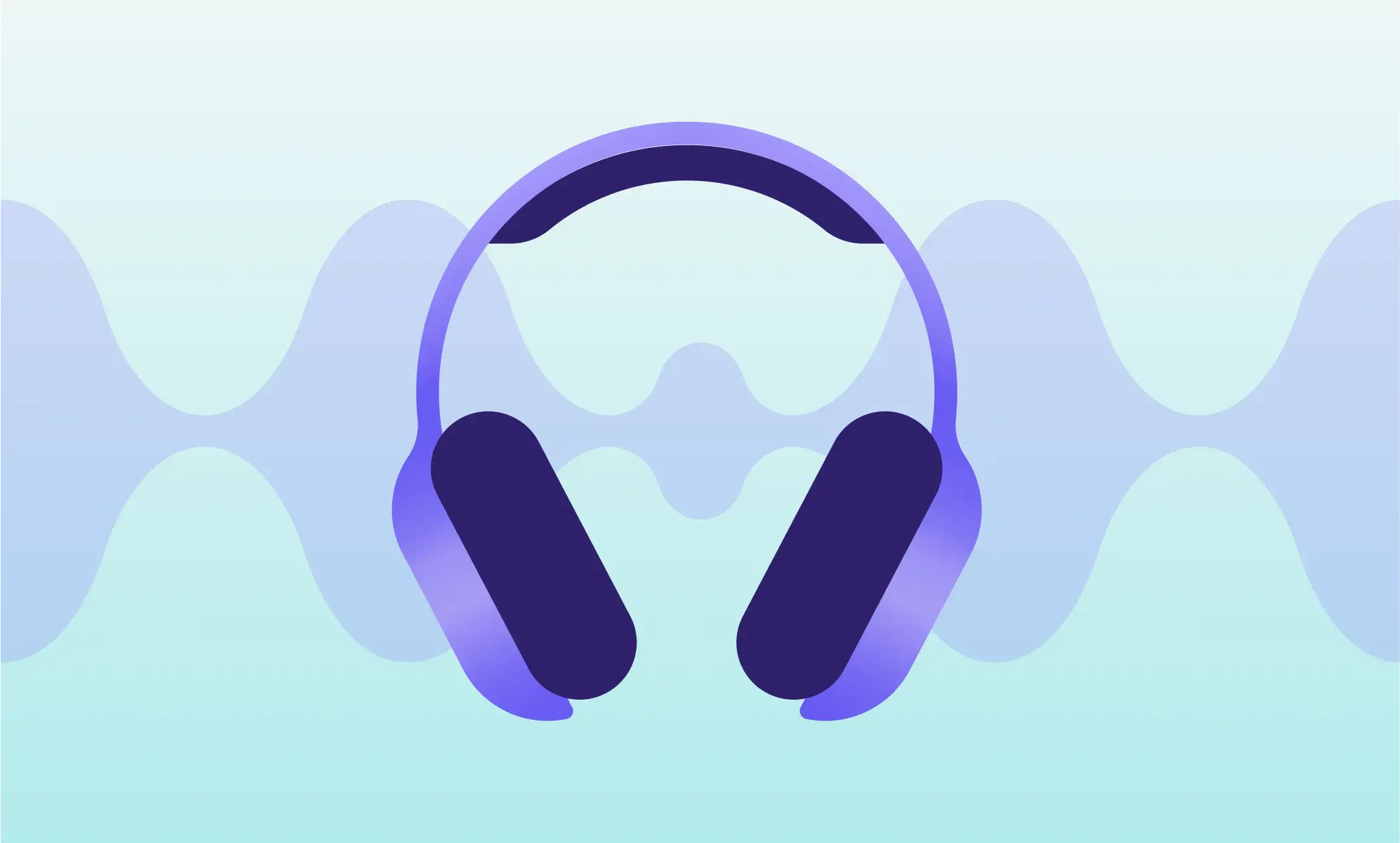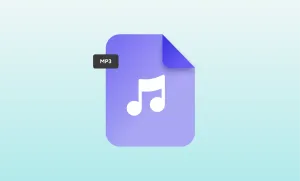Audio files come in all shapes and sizes but not all of them play nicely with your gear, your platform, or your audience. One sounds crystal clear but eats up storage. Another compresses beautifully but loses detail. Some are built for streaming, others for studio work. And some? Just plain confusing.
This guide cuts through the noise. We’ll unpack what audio file formats actually are, why they matter, and how to choose the right one for whatever you're creating. From high-fidelity masters to social-ready exports, you’ll learn how to get the best out of your audio and avoid the traps that trip up even seasoned creators.
Key Takeaways
- Different audio formats serve different purposes. MP3 and AAC are great for sharing and streaming, WAV and AIFF excel in editing and studio work, and FLAC or ALAC are ideal for archiving without losing quality.
- Compression impacts both quality and file size. Lossy formats like MP3 or OGG shrink files but remove some audio detail, while lossless formats like FLAC or ALAC preserve full fidelity in smaller sizes than uncompressed WAV or AIFF.
- Device and platform compatibility matters. MP3 works almost everywhere, AAC and M4A dominate Apple and streaming platforms, and formats like FLAC or DSD may require specific players.
- Choose formats based on workflow and audience. Use uncompressed or lossless files for recording and editing, and switch to compressed formats for distribution or streaming to save storage and bandwidth.
- Bitrate and sample rate decisions affect final sound. Higher bitrates (like 320kbps MP3) and standard sample rates (44.1kHz or 48kHz) guarantee cleaner audio and better playback across devices.
Common Audio File Formats
There’s no shortage of audio formats out there but not all of them serve the same purpose. Understanding the strengths (and quirks) of each can save you time, storage, and headaches, especially when you're working across different platforms or devices.
1. MP3
MP3 is the most recognized and widely used audio format on the planet. It earned its reputation by striking a solid balance between decent sound quality and small file sizes, making it ideal for music downloads, podcasts, and general sharing. MP3 uses lossy compression, which permanently removes some audio data to keep the files lightweight.
2. WAV
WAV files deliver pure, uncompressed audio. They store sound exactly as it was captured, with no quality loss or compression artifacts. This makes them the standard in professional recording studios and audio editing software. However, WAV files are huge.
3. FLAC
FLAC, or Free Lossless Audio Codec, is a favorite among audiophiles for a good reason. It reduces file size significantly, often by 40‑60%, without losing any of the original audio quality. FLAC is pretty much the efficient version of WAV.
4. AAC
AAC (Advanced Audio Coding) is the go‑to format for many streaming services and platforms, including YouTube, iTunes, and Apple Music. It’s a lossy format like MP3, but it’s more efficient, meaning you get better sound quality at the same bitrate.
5. AIFF
AIFF (Audio Interchange File Format) is Apple’s equivalent to WAV. Like WAV, it stores uncompressed PCM audio and delivers top‑tier sound quality, making it a solid choice for recording, editing, and mastering. However, the files are large.
6. OGG (Vorbis)
OGG, often used with the Vorbis codec, is a free and open‑source alternative to proprietary lossy formats like MP3 and AAC. It offers surprisingly good audio quality at lower bitrates. OGG is favoured in open‑source projects and some Android apps.
7. ALAC
ALAC (Apple Lossless Audio Codec) is Apple’s answer to FLAC. It compresses audio without removing any data, which means you retain full‑quality sound in a much smaller file. ALAC files are often wrapped in .m4a containers.
8. M4A
Think of M4A as a box that holds audio encoded with different codecs, most commonly AAC (lossy) or ALAC (lossless). This flexibility allows M4A files to deliver both high‑quality compressed audio and full‑resolution lossless sound.
9. Opus
Opus is a relatively new, compressed (lossy) format designed specifically for real‑time communication. It’s incredibly efficient, delivering clear audio with very low latency, which is why it’s used in apps like Zoom, Discord, and other VoIP platforms.
10. DSD
DSD (Direct Stream Digital) is a high‑resolution audio format originally developed for SACDs (Super Audio CDs). It uses a unique 1‑bit encoding system and extremely high sampling rates to capture audio with astonishing clarity and detail.
When to use which?
- For editing: WAV or AIFF
- For sharing: MP3, AAC, or M4A
- For archiving: FLAC or ALAC
- For streaming voice: Opus
- For hi-fi obsessives: DSD
What is a Codec?
A codec, short for coder‑decoder, is the algorithm that compresses or decompresses audio. It encodes audio for storage and decodes it for playback, affecting both sound quality and file size.
Think of it like packing a suitcase: the format is the suitcase itself, and the codec is how you pack it—neatly rolled to save space or stuffed in loosely.
Some formats are tied to a single codec, while others are flexible:
- MP3 is both a format and a codec.
- WAV is a container that usually uses PCM (uncompressed).
- MP4 can use multiple codecs like AAC or ALAC.
The right format‑codec combo helps you balance sound quality, file size, and compatibility. High‑res WAV files sound pristine but are huge. MP3s are lean and universal but lossy. FLAC preserves quality while trimming file size, but not every device supports it.
What is the Best Audio Format?
Choosing the “best” audio format means matching the format to your specific goals and workflow. Different formats excel in different areas, from uncompromising quality to universal compatibility.
Here’s a deep dive into what makes each format shine based on key factors every creator should consider:
1. Audio Quality and Editing Flexibility
If pristine sound and maximum control are your priorities, uncompressed or lossless formats reign supreme.
- WAV and AIFF are industry standards for professional editing because they preserve every bit of the original sound wave.
- FLAC also shines because it’s lossless, saving disk space without sacrificing quality.
- Editing software universally supports WAV and AIFF, while FLAC support is growing but sometimes requires conversion.
Bottom line: For recording and editing, use WAV, AIFF, or FLAC.
2. File Size and Storage Management
When file size matters, compressed formats are practical.
- MP3 and AAC shrink files to 10‑20% of their original size by removing inaudible audio data.
- AAC is more efficient than MP3 at the same bitrate.
- FLAC and ALAC cut file size 40‑60% without losing quality.
Bottom line: MP3 or AAC for sharing, FLAC or ALAC for lossless archiving.
3. Device Compatibility and Cross-Platform Use
Universal playback is crucial for reaching diverse audiences.
- MP3 is the most compatible format across all devices.
- AAC and M4A excel in Apple and modern streaming platforms.
- FLAC and ALAC are high quality but less supported on older devices.
Bottom line: MP3 is safest; AAC and M4A give a quality boost if your audience supports them.
4. Streaming and Social Media
Fast, reliable playback matters as much as quality.
- AAC dominates streaming platforms like Spotify, YouTube, and Apple Music.
- MP3 is common for podcasts and social uploads.
- Social platforms often transcode files anyway, so starting with MP3 or AAC avoids issues.
Bottom line: Export in MP3 or AAC for streaming and social sharing.
5. Podcasts and Voice Content
Podcasts need clarity, small file sizes, and wide compatibility.
- MP3 at 128kbps+ is the industry standard.
- AAC can sound slightly clearer but isn’t as universally supported.
- Higher bitrates or lossless formats rarely improve speech quality enough to justify the size.
Bottom line: Stick with MP3 for podcasts to maximize reach.
Compressed vs Uncompressed Audio
Audio can be stored in two fundamentally different ways: with compression or without it. One approach captures every sonic detail in full resolution. The other trims the fat to make files smaller, faster, and easier to work with.
This affects everything from how clean your podcast sounds to how quickly your music uploads, and even whether your audio plays correctly on someone’s phone.
Uncompressed Audio
Uncompressed formats like WAV and AIFF capture audio exactly as it was recorded. They preserve every detail, which makes them ideal for editing, mixing, and professional sound design. The trade‑off is that these files are huge, so they’re best for production and archival use rather than sharing or streaming.
Compressed Audio
Compressed formats make audio files smaller and easier to store or share. Lossy formats like MP3, AAC, and OGG permanently remove parts of the audio that are less noticeable to the human ear, which keeps files lightweight but slightly reduces quality. Lossless formats like FLAC and ALAC keep all of the original sound while still trimming file size, giving you studio‑quality audio in a more manageable package, though not every device supports them.
Which One is Better?
There’s no one-size-fits-all answer, it really depends on what you’re doing.
- If you’re editing, mixing, or archiving, go with uncompressed or lossless. Keep the full quality until the final export.
- If you’re sharing audio online, especially on platforms that re-encode anyway, lossy formats like MP3 or AAC are the smarter pick.
- If you want a middle ground, FLAC gives you quality and compression, but only if your workflow or platform supports it.
At the end of the day, it’s about what matters most: sound quality, file size, or ease of use. Pick your priorities, and let the format follow.
Audio Quality Tips to Keep in Mind
Good audio starts with smart decisions during recording, editing, and exporting, and a few small habits can make a big difference in how your content sounds.
Want great results when working with audio formats? Follow these simple tips:
- Record in the highest quality available. Always start with uncompressed or lossless files. You can compress later, but you can’t restore lost data.
- Normalize your audio before exporting. This keeps volume levels consistent across different devices and platforms.
- Use standard sample rates like 44.1kHz or 48kHz. These are industry standards for music and video, ensuring compatibility.
- Trim silence and add fades. Removing unnecessary silence and fading out avoids awkward jumps or glitches on streaming platforms.
- Convert files carefully. Avoid converting from one lossy format to another (e.g., MP3 to AAC) to prevent further quality loss.
- Monitor your audio levels. Keep peaks around -6 dB to prevent distortion and clipping.
- Use headphones or quality monitors for editing. This helps catch subtle issues that cheaper speakers might miss.
- Check your audio on multiple devices. Test playback on phones, laptops, and earbuds to ensure consistent quality.
- Keep backups of original files. Always save your unedited source files in case you need to revisit or re-export.
Get Better Audio Quality with Podcastle
Creating great audio doesn’t have to be complicated. Podcastle makes recording, editing, and polishing your sound effortless, with smart AI tools working behind the scenes to handle the technical stuff.
Here is what you can do with Podcastle’s audio editor:
- Record and clean up audio with ease – Capture studio‑quality sound remotely, while AI automatically removes background noise, silence, and uneven levels.
- Enhance your sound instantly – Use Magic Dust to boost your audio to studio quality without complicated mixing.
- Edit quickly and intuitively – Split, trim, fade, and adjust speed with simple drag‑and‑drop controls.
- Add music and voiceovers – Access a library of royalty‑free music and sound effects, or generate natural AI voiceovers in multiple voices and accents.
- Export and convert in multiple formats – Save in MP3, WAV, FLAC, AAC, and more, or convert video files to audio in one step.
Ready to start? Try Podcastle’s audio editor today.
FAQ
What audio file format is best for use on the web?
MP3 is the most reliable format for the web - small, fast-loading, and universally supported.
WAV vs MP3: What’s better?
Both formats serve different purposes depending on your needs and the specifics of your project.
- WAV: Better quality, huge file size, ideal for editing.
- MP3: Smaller size, great for sharing and distribution, slightly lower quality.
FLAC vs MP3: What’s better?
When deciding between FLAC and MP3, it’s important to consider your priorities around quality and file size:
- FLAC is lossless; perfect if you need high-quality archiving.
- MP3 is lossy but practical for streaming and downloads.
128kbps vs 320kbps: What’s the difference?
Bitrate affects how much audio data is stored per second, impacting both quality and file size. Both 128kbps and 320kbps are MP3 bitrates:
- 128kbps: Smaller, faster to load, but noticeably less detailed.
- 320kbps: Near-CD quality, better for music and professional audio.
Choosing the right bitrate means deciding between smaller file sizes and better sound quality, based on how and where your audio will be listened to.
How to convert video to MP3?
With Podcastle, it’s as simple as drag and drop. Just upload your video file into our audio editor, and Podcastle will automatically extract and convert it to an MP3 that you can download. It’s all a walk in the park.
What is the best audio file format for iTunes?
AAC is the best all-around format for iTunes, offering great audio quality with efficient file sizes and full support across Apple devices. However, if you want lossless quality that preserves every bit of the original sound, ALAC is the way to go, especially for archiving or audiophile listening within the Apple ecosystem.
What is the best audio file format for YouTube?
YouTube supports several formats including MP3, WAV, FLAC, and AAC. For the best audio quality, upload lossless files like FLAC or uncompressed WAV. MP3 is also supported and works well, but lossless formats offer higher fidelity.








